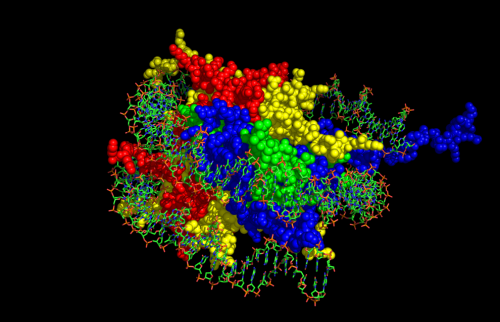Scientists unlock tangled mysteries of DNA

Chromosomal proteins hold the key to our DNA and they are changing, according to Jose Eirin-Lopez, marine sciences professor in the Florida International University Department of Biological Sciences.
While today's human body contains a variety of these proteins, Eirin-Lopez believes they evolved from a single ancestor millions of years ago. This finding, published recently in Molecular Biology and Evolution, is pivotal in unraveling the mysteries of DNA organization and regulation, and could someday lead to innovative biomonitoring strategies and therapies targeting a variety of diseases including cancer.
DNA is the recipe for all living things. Each of our cells has a DNA molecule enclosed within its nucleus, containing the entirety our genetic information. However, like a recipe book, not all that information is required at the same time. Most DNA remains tightly packaged in chromosomes until specific pieces of information are needed to do a job.
It is up to a group of proteins known as chromosomal proteins to unlock the information required to trigger a function in a given cell—to form a bone, determine eye color, metabolize food, fight infections or any other function. While significant information is available about the structure and functions of chromosomal proteins, very little is known about their origin and evolution. The team of researchers is the first to explain the mechanisms responsible for the evolutionary diversification of a specific group of chromosomal proteins known as High Mobility Group Nucleosome-binding (HMG-N) proteins.
"In the early stages of life on earth, cells were rudimentary yet still able to perform their jobs. But evolution, through mutations, drift and natural selection, has led these proteins (along with our cells) to evolve into higher performers," said Eirin-Lopez who co-authored the study with Rodrigo Gonzalez-Romero from FIU and Juan Ausio from the University of Victoria in Canada.
The research unveils the mechanisms responsible for the functional specialization of this group of proteins, from a common ancestor directing a variety of activities to the actual HMG-N lineages working in concert in vertebrate organisms including humans. However, along with a better cell performance, a higher number of chromosomal proteins also provide more potential targets for harmful mutations. If one or more of these proteins are altered or mutated they will target wrong genes in the DNA, giving erroneous instructions to cells. The potential health consequences of such mistakes are massive, often causing cells to grow uncontrollably and resulting in cancer.
"The only way we can alleviate the negative effects of these alterations is by getting an exhaustive knowledge about these proteins and their function, helping us to develop therapies to reinstate the correct communication with DNA and the cell," Eirin-Lopez said. "Nonetheless, our knowledge about chromosomal proteins will never be complete until we determine how they came to be and to fulfill their current roles in the cell. Only evolutionary analyses can answer that question. Understanding this better prepares us to take action in the future."
More information: Evolution of High Mobility Group Nucleosome-Binding Proteins and Its Implications for Vertebrate Chromatin Specialization, Molecular Biology and Evolution, mbe.oxfordjournals.org/content/32/1/121.abstract
Journal information: Molecular Biology and Evolution
















